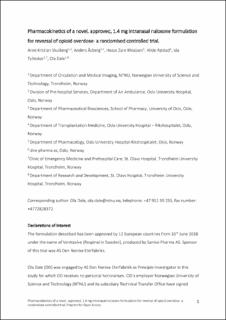Pharmacokinetics of a novel, approved, 1.4-mg intranasal naloxone formulation for reversal of opioid overdose—a randomized controlled trial
Skulberg, Arne Kristian; Åsberg, Anders; Zare, Hasse Khiabani; Røstad, Hilde; Tylleskär, Ida; Dale, Ola
Peer reviewed, Journal article
Accepted version

Åpne
Permanent lenke
https://hdl.handle.net/11250/2650948Utgivelsesdato
2019Metadata
Vis full innførselSamlinger
Sammendrag
Background and aims
Intranasal (i.n.) naloxone is an established treatment for opioid overdose. Anyone likely to witness an overdose should have access to the antidote. We aimed to determine whether an i.n. formulation delivering 1.4 mg naloxone hydrochloride would achieve systemic exposure comparable to that of 0.8 mg intramuscular (i.m.) naloxone.
Design
Open, randomized four‐way cross‐over trial.
Setting
Clinical Trials Units in St Olav's Hospital, Trondheim and Rikshospitalet, Oslo, Norway.
Participants
Twenty‐two healthy human volunteers, 10 women, median age = 25.8 years.
Intervention and comparator
One and two doses of i.n. 1.4 mg naloxone compared with i.m. 0.8 mg and intravenous (i.v.) 0.4 mg naloxone.
Measurements
Quantification of plasma naloxone was performed by liquid chromatography tandem mass spectrometry. Pharmacokinetic non‐compartment analyses were used for the main analyses. A non‐parametric pharmacokinetic population model was developed for Monte Carlo simulations of different dosing scenarios.
Findings
Area under the curve from administration to last measured concentration (AUC0‐last) for i.n. 1.4 mg and i.m. 0.8 mg were 2.62 ± 0.94 and 3.09 ± 0.64 h × ng/ml, respectively (P = 0.33). Maximum concentration (Cmax) was 2.36 ± 0.68 ng/ml for i.n. 1.4 mg and 3.73 ± 3.34 for i.m. 0.8 mg (P = 0.72). Two i.n. doses showed dose linearity and achieved a Cmax of 4.18 ± 1.53 ng/ml. Tmax was reached after 20.2 ± 9.4 minutes for i.n. 1.4 mg and 13.6 ± 15.4 minutes for i.m. 0.8 mg (P = 0.098). The absolute bioavailability for i.n. 1.4 mg was 0.49 (±0.24), while the relative i.n./i.m. bioavailability was 0.52 (±0.25).
Conclusion
Intranasal 1.4 mg naloxone provides adequate systemic concentrations to treat opioid overdose compared with intramuscular 0.8 mg, without statistical difference on maximum plasma concentration, time to maximum plasma concentration or area under the curve. Simulations support its appropriateness both as peer administered antidote and for titration of treatment by professionals.